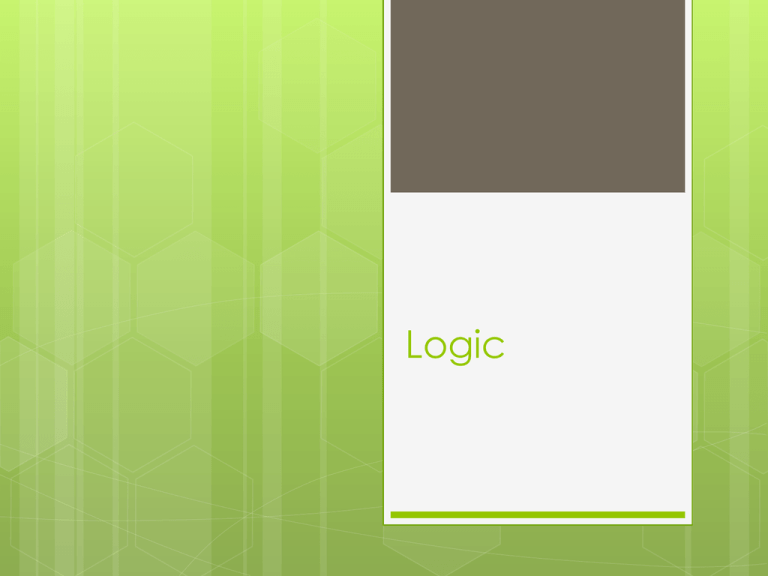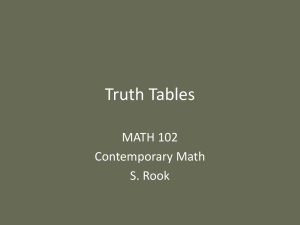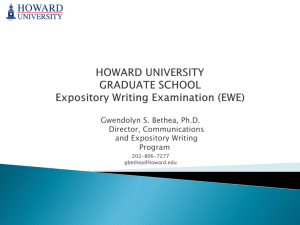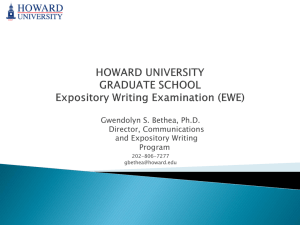Logic - mrcampbellsmath
advertisement

Logic What is Logic? logic is a process people use to infer one thing from another logic is the root of all mathematics and is the root of all rational thought (truth) Symbolic Logic Symbolic logic, also known as mathematical logic, is a subfield of mathematics. Example 𝑞 ∨ 𝑟 𝑖𝑛𝑑𝑖𝑐𝑎𝑡𝑒𝑠 q or r 𝑝 ∧ 𝑞 𝑖𝑛𝑑𝑖𝑐𝑎𝑡𝑒𝑠 𝑝 𝑎𝑛𝑑 𝑞 Worded Expressions Translating from English to symbols. But and neither-Nor Example Dogs bark and cats meow. Symbols The symbol ~ denotes not pΛq denotes “p and q” pVq denotes “p or q” ∀ denotes “for all” ∃ denotes “there exists” p⊕q denotes “p or q but not both p and q” P≡Q denotes “P is logically equivalent to Q” p→q denotes “if p then q” Symbolic Logical Expressions Given a statement p, the sentence “~p” is read “not p” or “It is not the case that p” and is called the negation of p. Example 𝐴 ∨ 𝐵 ∧ ~𝐶 → 𝐷 It If A or B and if not C, Then D is not hot and it is sunny. Letting h=“it is hot” and s=“it is sunny” ~ℎ ∧ 𝑠 Practice Translate the symbolic expression to a worded expression. (~𝐴 ∨ ~𝐵) ∧ 𝐶 → 𝐷 Practice Translate the worded expression to a symbolic expression. Let h=“it is hot” and s=“it is sunny” It is neither hot nor sunny. De Morgan’s Laws The negation of an and statement is logically equivalent to the or statement in which each component is negated. The negation of an or statement is logically equivalent to the and statement in which each component is negated. Example Write the negation for the following statement. John is 6 feet tall and he weighs at least 200 pounds. John is not 6 feet tall or he weighs less than 200 pounds. Example Write the negation for the following statement. The bust late or Tom’s watch was slow. The bus was not late and Tom’s watch was not slow. Individual Practice Use De Morgan’s laws to write the negations for the statements. Sam is an orange belt and Kate is a red belt. The connector is loose or the machine is unplugged. Hal is a math major and Hal’s sister is a computer science major. Conjunction of p and q The sentence “pΛq” is read “p and g” and is called conjunction of p and q. It is true when, and only when, both p and q are true. If either p or q is false, or if both are false, p and q is false. Disjunction of p and q The sentence “pVq” is read “p or q” and is called the disjunction of p and q. It is true when either p is true, or q is true, or both p and q are true; it is false only when both p and q are false. Example Letting h = “It is hot” and s = “It is sunny” write each of the following sentences symbolically. It is not hot but it is sunny. ~hΛs. It is not hot and it is not sunny. ~h Λ~s. Practice Let s = “stocks are increasing” and i=“interest rates are steady.” Stocks are increasing but interest rates are steady Neither are stocks increasing nor are interest rates steady. Practice Juan is a math major but not a computer science major. (m=Juan is a math major, c= Juan is a computer science major) Principles of Logic Objective: SWBAT establish logical consequences through the use of truth tables, syllogism, and deductive reasoning. Logical Consequences Logical consequence is a fundamental concept in logic. It is the relation that holds between a set of sentences (or propositions) and a sentence (proposition) when the former "entails" the latter. Example 'Kermit is green' is said to be a logical consequence of 'All frogs are green' and 'Kermit is a frog', because it would be "selfcontradictory" to affirm the latter and deny the former. "If it isn't obvious, it isn't logical." -Nelsen Truth Tables Truth tables can be used to tell whether a propositional expression is true for all legitimate input values, that is, logically valid. Example Conjunction P q pΛq T T T T F F F T F F F F Example Disjunction P q pVq T T T T F T F T T F F F Syllogism A syllogism or logical appeal is a kind of logical argument in which one proposition (the conclusion) is inferred from two others (the premises) of a certain form. Syllogism Continued Syllogisms are arguments that take several parts, normally with two statements which are assumed to be true that lead to a conclusion. Major premise: A general statement. Minor premise: A specific statement. Conclusion: based on the two premises Example Aristotle's Syllogism If all humans are mortal, and all Greeks are humans, then all Greeks are mortal. Deductive Argument A deductive argument is an argument in which it is thought that the premises provide a guarantee of the truth of the conclusion. Deductive Argument Continued In a deductive argument, the premises are intended to provide support for the conclusion that is so strong that, if the premises are true, it would be impossible for the conclusion to be false. Example All men are mortal. Joe is a man. Therefore Joe is mortal. If the first two statements are true, then the conclusion must be true. Statement Composition A statement (or proposition) is a sentence that is true or false but not both. Inverse A conditional statement and its inverse are not logically equivalent. Suppose a conditional statement of the form “If p then q” is given. The inverse is “If ~p then ~q.” Example If Howard can swim across the lake, then Howard can swim to the island. Inverse: If Howard cannot swim across the lake, then Howard cannot swim to the island. Practice Write the inverse of the following statement. If today is Easter, then tomorrow is Monday. Converse A conditional statement and its converse are not logically equivalent. Suppose a conditional statement of the form “If p then q” is given. The converse is “If q then p.” Example If Howard can swim across the lake, then Howard can swim to the island. If Howard can swim to the island, then Howard can swim across the lake. Practice Write the converse of the following statement. If today is Easter, then tomorrow is Monday. Contrapositive The contrapositive of a conditional statement of the form “If p then q” is If ~q then ~p. Symbolically, The contrapositive of 𝑝 → 𝑞 is ~𝑞 → ~𝑝. Example If Howard can swim across the lake, then Howard can swim to the island. Contrapositive: If Howard cannot swim to the island, then Howard cannot swim across the lake. Practice Write the contrapositive of the following statement. If today is Easter, then tomorrow is Monday. Logically Equivalent Two statement forms are called logically equivalent if, and only if, they have identical truth values for each possible substitution of statements for their statement variables. The logical equivalence of statement forms P and Q is denoted by writing P ≡ Q. Testing Step 1: Construct a truth table for P with one column for the truth values of P and another column for the truth values of Q. Step 2: Check each combination of truth values of the statement variables to see whether the truth value of P is the same as the truth value of Q. Step 2 Continued If in each row the truth value of P is the same as the truth value of Q, then P and Q are logically equivalent. If in some row P has a different truth value from Q, then P and Q are not logically equivalent. Wrap-up









